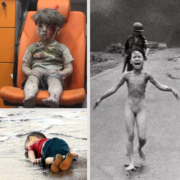When a picture is no longer worth a thousand words- World is changing

Alan Kurdi’s tragic photograph did have a significant impact when it was widely circulated in 2015. It served as a poignant symbol of the refugee crisis stemming from the Syrian civil war and generated a wave of public empathy and outcry. The image of a lifeless child washed ashore on a beach was a powerful and heart-wrenching reminder of the human cost of conflicts and the desperation of refugees. It spurred discussions, awareness, and calls for action regarding the refugee crisis and the need for more humane immigration policies.
However, your point about the saturation of images and information in the media is valid. In a world where we are bombarded with images and news from various sources on a daily basis, it can be challenging for any single image to maintain a lasting impact. People may become desensitized to the constant stream of tragedies, and their attention may shift quickly to other news or events, including those that are more lighthearted or frivolous in nature.
Nonetheless, photographs can still be powerful tools for raising awareness and influencing public opinion. While the initial impact of an image may fade over time, it can still contribute to a broader understanding of ongoing issues and inspire discussions and actions. Activists, journalists, and organizations often use visual storytelling to keep important issues in the public eye and push for change.
In the cases of Syria, Ukraine, Gaza, and other conflict zones, the challenge is to sustain attention and action on the issues and individuals affected. It requires a combination of compelling visuals, consistent reporting, and advocacy efforts to maintain public awareness and support for those in need.
The phrase “a picture is worth a thousand words” is often used to suggest that a single image can convey complex ideas and emotions more effectively than a lengthy description. However, there are situations where a picture may no longer be worth a thousand words or may even be misleading or insufficient in conveying information. Here are a few scenarios where this might occur:
- Misleading or manipulated images: In the age of digital manipulation, images can be altered to convey false information or create misleading impressions. In such cases, a picture may not accurately represent the reality it claims to depict.
- Lack of context: A picture may not provide sufficient context to understand the full story. Without accompanying information or background, it may be open to misinterpretation.
- Complexity of the subject: Some topics or issues are highly complex and cannot be adequately conveyed through a single image. In these cases, words or explanations are necessary to provide a comprehensive understanding.
- Evolving situations: In rapidly changing or dynamic situations, a static image may quickly become outdated or fail to capture the ongoing developments.
- Abstract or conceptual ideas: Concepts or abstract thoughts may not easily translate into visual representations. Words are often better suited to explain these ideas.
- Personal interpretations: Different people may interpret an image in various ways, leading to a lack of consensus or understanding. Words can help clarify and provide a shared understanding.
- Emotional depth: While an image can evoke emotions, it may not always express the depth and nuances of human feelings as effectively as words can. Personal experiences and perspectives also play a significant role in emotional interpretation.
In these situations, a picture may not be worth a thousand words, and written or spoken language may be required to provide a more accurate, complete, or nuanced understanding of a subject. Words can provide the necessary context, clarification, and explanation that an image alone might lack.


